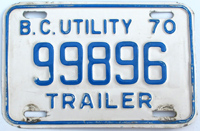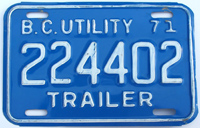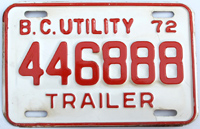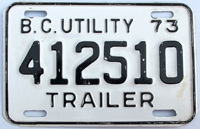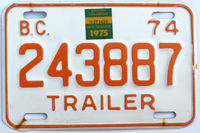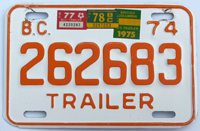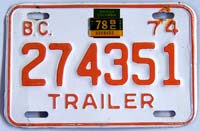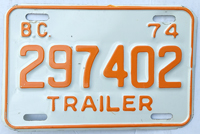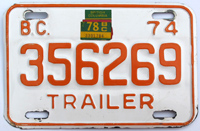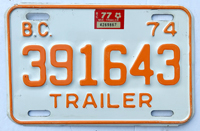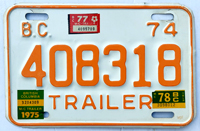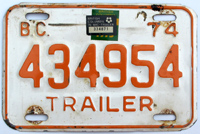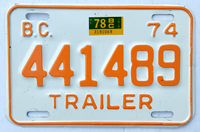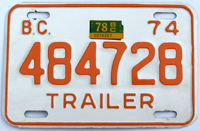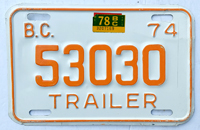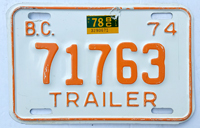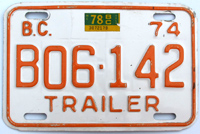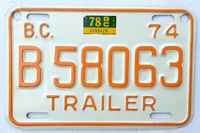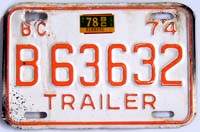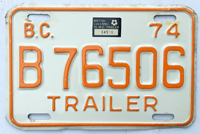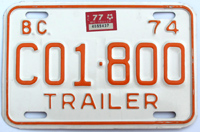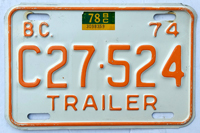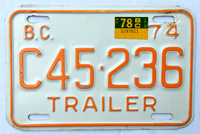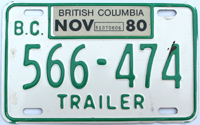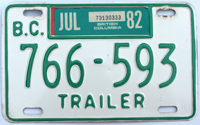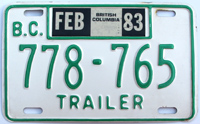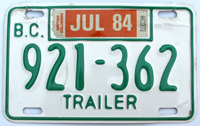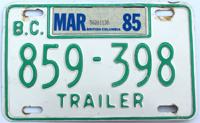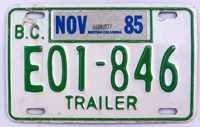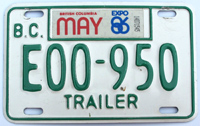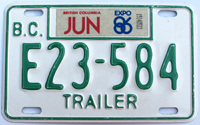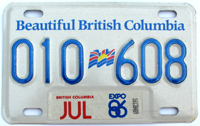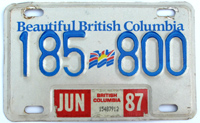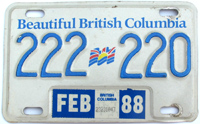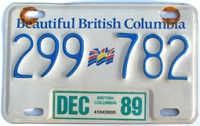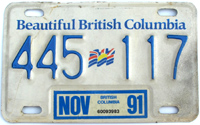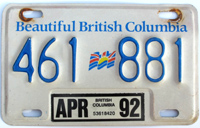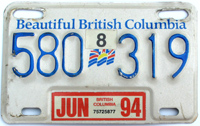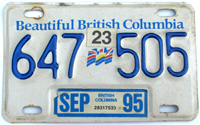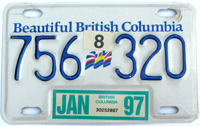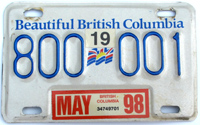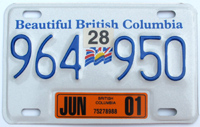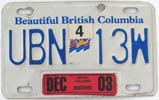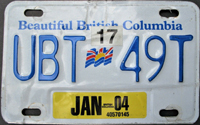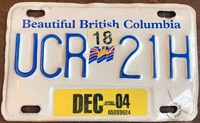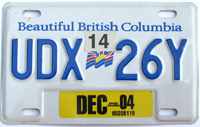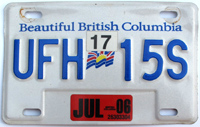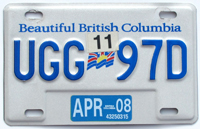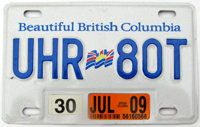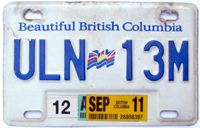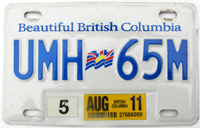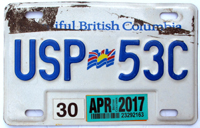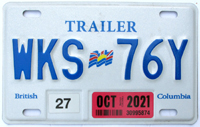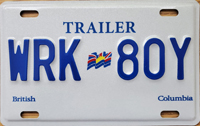|
British
Columbia Utility Trailer License Plates

In 1955, the province reclassified trailers into two different types and created a new plate; the "Utility Trailer", to reflect this change: |
.jpg)
Commercial Trailer license plate |
.jpg)
Utility Trailer license plate |
It is generally thought that the new "Utility Trailer" plates were assigned to trailers used primarily for residential purposes, such as boat trailers or u-bilt trailers (it is understood that there may have been a weight limit of 1,500 pounds). The Utility plates would be in use from 1955 to 1973 and would undergone one minor design change (in 1969 when the date began to be stamped in the top right corner of the plates). |
| 1955 - 1969: |
|
|
|
|
Issuing
Statistics |
1955:
|
20-001 to 35-000 |
1956:
|
unknown |
1957:
|
unknown |
1958:
|
unknown |
1959:
|
unknown |
1960:
|
unknown |
1961:
|
unknown |
1962:
|
unknown |
1963:
|
unknown |
1964:
|
20001 to 88000 |
1965:
|
20001 to 95000 |
1966:
|
20001 to 99000 |
1967:
|
20001 to 99000 |
1968:
|
20001 to 99999 |
1969:
|
25001 to 151000 |
|
|
|
|
|
|
|
|
|
|
|
|
|
|
| 1968 - Over-run / Error plate |
The plate shown below is a particularly egregious example of an error plate that was most likely rushed through the production plant at Oakalla Prison Farm in late 1968 as over-run in order to address a shortfall in supply: |
|
The first give-away is that the serial is in excess of that listed in the records maintained by the MVB, which indicate that the run for 1968 was to be 99,999. That this particular plate is over 100,000 clearly indicates an additional allotment was stamped out. |
Also of interest is that the plate displays the rather common error of mismatching dies on the serial (i.e. compare the two middle no. `1`s). Finally, something very important is missing! If you haven`t already picked-up on it, the word `TRAILER` has not been included on the bottom of the plate. Wow! They must have really been in a rush ... |
The design used for the plate is also the one that was to be used for the 1969 base (see image below). It was likely that Oakalla was already producing the 1969 plates at the time that additional 1968`s were required, and rather than revert back to old design a decision was made to use the new base. |
| |
|
TYPE I (5-DIGIT) - STACKED DATE AT RIGHT |
TYPE II (6 DIGIT) - DATE AT TOP RIGHT |
|
*
* * * * |
In 1970, the plates underwent a design change with the date beginning to be stamped in the top right corner of the plates. |
It is also interesting to note that, for those years that records are available, the bloc of numbers assigned to Utility plates generally commences around 5,000 numbers after that bloc given to the Commercial Trailer series. |
For instance, in 1967, the Commercial series went from 1 to 16,000, whereas the Utility series commenced at 20,001 through to 99,000. |
| 1970 - 1973: |
|
|
|
|
Issuing
Statistics |
1970:
|
25001 to 159000 |
1971:
|
100001 to 240000 |
1972:
|
300001 to 460000 |
1973:
|
300001 to 467000 |
|
|
In 1974, the design of the plate was brought into conformity with most other non-passenger types through the use of the orange-on-white colour scheme. The most notable change to the actual plate is the dropping of the word "Utility". |
Also if interest is the first known use of the Allocation Code of '05' for "Utility Trailer" plates in 1974. This code continues to be used on the Corporation's BC Licence Plate Identification Guide. |
| 1974 - 1978 |
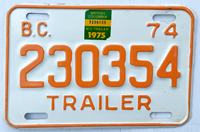
|
|
|
|
Issuing
Statistics |
1974:
|
226-001 to 256-000 |
1974:
|
266-001 to 476-000* |
1975:
|
476-001 to 500-000 |
1976:
|
40-001 to 80-000 |
1977:
|
B00-001 to B99-999 |
1977:
|
C00-001 to C50-000 |
*
MVB Records for 1974 indicate plates in this range to be an
"Additional Allotment"
|
|
|
|
|
|
|
|
|
|
|
|
|
|
|
|
|
|
|
|
|
|
|
|
|
|
|
|
|
|
| 1979 - 1986 |
|
|
|
|
Issuing
Statistics
|
1979:
|
500-000 to 999-900 |
1983:
|
E00-000 to E10-999 |
????
|
E11-000 to E25-999 |
|
|
|
|
|
|
|
|
|
|
| 1986 - 2001 |
|
|
|
|
Issuing
Statistics
|
1985:
|
000-001 to 244-999 |
1986:
|
245-000 to 304-999 |
1987:
|
305-000 to 361-999 |
1989:
|
362-000 to 405-999 |
1990:
|
406-000 to 470-999 |
1991:
|
471-000 to 510-499 |
1992:
|
510-500 to 553-499 |
1993:
|
553-500 to 603-899 |
1993:
|
603-900 to 658-899 |
1994:
|
658-900 to 716-899 |
|
|
|
|
|
|
|
|
|
|
|
|
|
|
With the exhaustion of the all-numeric series around 2000, ICBC introduced the use of letters in a "AAA-00A" format. |
| 2000 - 2004: Letters (Astrographics dies) |
|
|
|
|
|
|
|
|
|
|
|
|
|
 |
This photo nicely encapsulates the challenges of trying to date the issuance of a plate based upon the decal. |
| 2002 - 2016: Letters (Waldale dies) |
|
|
|
|
|
|
|
|
|
|
|
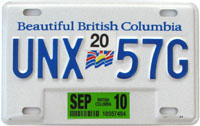 |
|
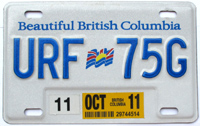 |
|
|
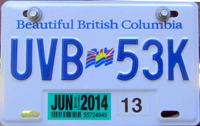 |
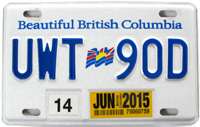 |
|
|
|
| Olympic Utility Trailer Plate |
In 2007, the Utility Trailer plate was one of the lucky six plate types along with passenger, truck, motorcycle, farm truck and trailer to be made available on the optional 2010 Olympic Winter Games base. |
|
The prefix used on the plate was "UYM", and it is thought that a bloc of only 1,000 plates may have been set aside for use on this base (as only 557 plates were issued). |
| Utility Trailer "Trailer" Plate |
In a rather surprising move, the Corporation took the opportunity of the "UAA" format running out of combinations to undertake a redesign of the Utility Trailer plates! |
The new plates, which start at "WAA-00A", have the dual decal wells first seen on the Olympic plates as well as the small fonr "British Columbia" on either side of the decals. Rather unusual is the dropping of the "Beutiful" slogan in favour of the word "TRAILER" along the top centre. Acording to ICBC, this was to assist in the identification of these plates for use on trailers as opposed, one assumes, to motorcycles. This is the first time since the "Flag" series was introduced in 1985-86 that the "Beautiful" slogan has not appeared on the Utility Trailer plates.
|
Being us, we here at BCpl8s.ca feel the need to point out that the title of "TRAILER" is somewhat incorrect (or at least incomplete) as these are being affixed to what the Corporation classifies as "Utility Trailers", which are not to be confused with a "Commercial Trailer" or "Trailer Floater".
|
In addition, if the intent of the redesign was to improve the identification of these types of plates, we wonder why this opportunity was not used to also introduce the larger dies used on the Motorcycle series to assist in the identification of the serial on these plates? |
Finally, it was our understanding that any time a plate type underwent a redesign (i.e. Foreign Representative). |
| 2015 to present: "TRAILER" |
|
|
|
|
|
|
|
|
|
 |
The standard size of trailer plates in BC is 5x8, which can cause some problems when trying to mount them on a trailer purchased in the US where trailer plates tend to be the standard passenger vehicle size of 6x12. |

© Copyright Christopher John
Garrish. All rights reserved.
|
.jpg)
.jpg)
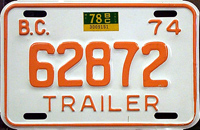
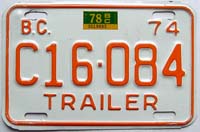
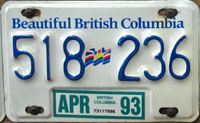
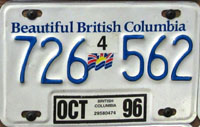





.jpg)
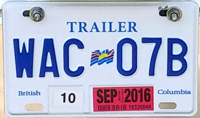

.jpg)

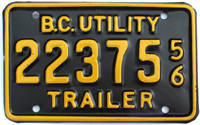
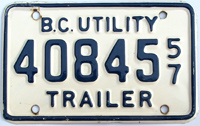
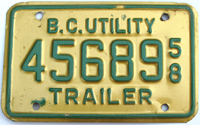
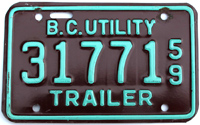
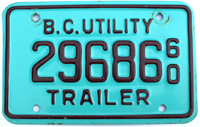
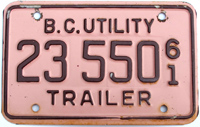
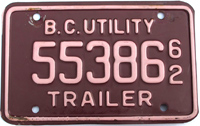
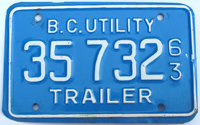
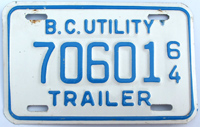
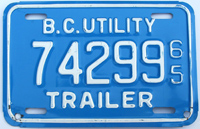

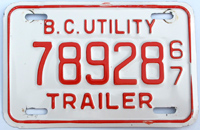
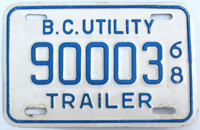
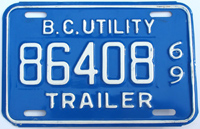
.jpg)
.jpg)
